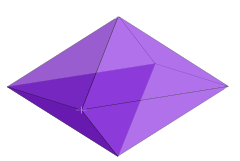Hyperrectangle
| Hyperrectangle n-orthotope | |
|---|---|
 A rectangular cuboid is a 3-orthotope | |
| Type | Prism |
| Facets | 2n |
| Vertices | 2n |
| Schläfli symbol | {} × {} ... × {} |
| Coxeter-Dynkin diagram | |
| Symmetry group | [2n-1], order 2n |
| Dual | Rectangular n-fusil |
| Properties | convex, zonohedron, isogonal |
In geometry, an n-orthotope[1] (also called a hyperrectangle or a box) is the generalization of a rectangle for higher dimensions, formally defined as the Cartesian product of intervals.
Types
A three-dimensional orthotope is also called a right rectangular prism, rectangular cuboid, or rectangular parallelepiped.
A special case of an n-orthotope, where all edges are equal length, is the n-cube.[1]
By analogy, the term "hyperrectangle" or "box" refers to Cartesian products of orthogonal intervals of other kinds, such as ranges of keys in database theory or ranges of integers, rather than real numbers.[2]
Dual polytope
| n-fusil | |
|---|---|
 Example: 3-fusil | |
| Facets | 2n |
| Vertices | 2n |
| Schläfli symbol | {} + {} + ... + {} |
| Coxeter-Dynkin diagram | |
| Symmetry group | [2n-1], order 2n |
| Dual | n-orthotope |
| Properties | convex, isotopal |
The dual polytope of an n-orthotope has been variously called a rectangular n-orthoplex, rhombic n-fusil, or n-lozenge. It is constructed by 2n points located in the center of the orthotope rectangular faces.
An n-fusil's Schläfli symbol can be represented by a sum of n orthogonal line segments: { } + { } + ... + { }.
A 1-fusil is a line segment. A 2-fusil is a rhombus. Its plane cross selections in all pairs of axes are rhombi.
| n | Example image |
|---|---|
| 1 | { } |
| 2 | .png) { } + { } |
| 3 |  Rhombic 3-orthoplex inside 3-orthotope { } + { } + { } |
See also
Notes
- 1 2 Coxeter, 1973
- ↑ See e.g. Zhang, Yi; Munagala, Kamesh; Yang, Jun (2011), "Storing matrices on disk: Theory and practice revisited" (PDF), Proc. VLDB, 4 (11): 1075–1086.
References
- Coxeter, Harold Scott MacDonald (1973). Regular Polytopes (3rd ed.). New York: Dover. pp. 122–123. ISBN 0-486-61480-8.
